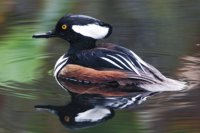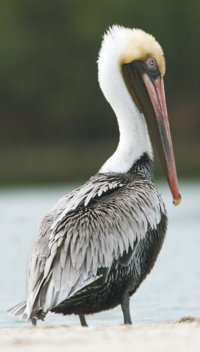

Habitat restoration grants available
Printer Friendly Page
The Gulf of Maine Council/National Oceanic and Atmospheric Administration Habitat Restoration Partnership recently announced its sixth round of coastal and riverine habitat restoration grants for the Gulf of Maine.
The Partnership has granted $1.5 million to 56 local, state and non-profit organizations in the U.S. and Canadian Gulf of Maine since 2001. The financing has gone toward projects that include restoring tidal flow to salt marshes, improving passage for native sea-run fish and monitoring habitat restoration efforts.
This year there is $386,000 available for habitat restoration projects within the Gulf of Maine. The region extends from the tip of Cape Cod, Massachusetts to Cape Sable, Nova Scotia, and includes all coastal watersheds. Projects beyond this geographic range may be considered if it is shown that the proposed project will provide direct benefits to the Gulf of Maine ecosystem.
Non-governmental organizations (e.g., community associations, cooperatives, civic groups), municipalities, schools and tribal and state governments are encouraged to apply. Eligible projects include those that will result in on-the-ground restoration of habitat to benefit living marine resources, including anadromous fish species.
To apply for these grants, please visit the Gulf of Maine Habitat Restoration Web site (http://gulfofmaine.org/habitatrestoration) and look for the 2006 RFP. Final applications are due on or before November 17.
For additional information contact:
Brook trout historically have served as a barometer for good water quality and a healthy watershed. But the beautiful fish now occupy less than half of their original range in Massachusetts. That also reflects their condition across the whole eastern United States, according to a new report by Trout Unlimited and a coalition of state and federal agencies. "Brook trout are the canary in the coal mine when it comes to water quality," said Gary Berti, Trout Unlimited's Eastern Brook Trout Campaign Coordinator. "The presence of brook trout in a watershed indicates that water quality is excellent. Declining brook trout populations can provide an early warning that the health of an entire stream, lake or river is at risk." The fish have thrived in rivers and streams from Maine to Georgia, but land use has pushed the remaining isolated populations to the headwaters of high-elevation streams.
In the case of Massachusetts, the few remaining patches of good quality brook trout habitat are in the Berkshire and Taconic mountains and part of the Hoosic, Deerfield and Westfield watersheds and several tributaries to the Connecticut River. The fish have been eliminated from 7 percent of their historic range in the state. They are greatly reduced in 20 percent of their habitat. And the population status is unknown in 42 percent of the historic range. Todd Richards, aquatic biologist of the Massachusetts Division of Fish and Wildlife, said the results are "sobering," but added that the state already is pursuing ways to conserve the remaining habitat and restore impaired streams.
Warren Winders, brook trout coordinator for Trout Unlimited's Massachusetts Council, said brook trout are quick to respond to habitat improvements, as evidenced in noticeable improvements in the Quashnet River and Red Brook in southeastern Massachusetts.
Fish and wildlife agencies from 17 states, federal partners, conservation organizations and academic institutions participated in the study. For the full report, "Eastern Brook Trout: Status and Threats," see www.brookie.org.
MIT Sea Grant has published a pamphlet, "Life and Fresh Seafood: Into the Pan, Not Into the Wild," aimed at educating consumers to not release or dump live and fresh seafood and seafood waste into the wild. Dumping seafood, particularly non-native species, into the water can introduce invasive animals and the plants they are packed in during shipping. The northern snakehead fish and the Chinese mitten crab are two examples of alien species that are currently invading parts of the United States, causing environmental damage such as erosion or flooding. The Chinese mitten crab eats saltwater plants, salmon and sturgeon eggs, shrimp and young fish.
It is illegal in the United States to release non-native, invasive live fish and turtles into the wild: those caught doing so could be fined or jailed. Fish that are illegal to possess without a permit include the black carp (illegal in Connecticut, Maine and Hew York), the grass carp or white amus (illegal in Connecticut, Massachusetts, Maine and New Hampshire), the silver carp (illegal in Connecticut, Maine and New York), and the bighead carp (illegal in Connecticut, Maine and parts of New York). To get a copy of the pamphlet in English, Chinese, Vietnamese, Khmer, Korean or Spanish visit http://massbay.mit.edu/seafood.
A group of 156 endangered Northern Red-bellied Cooters turtles, formerly known as Plymouth Red-belly turtles, were weighed, marked and released in Massachusetts this summer as part of an effort to reduce mortality during their first year of life. The turtles were removed from the wild last fall and placed in educational and scientific facilities, where they had an unlimited food supply and a comfortable, warm aquarium in which to live.
The program, run by Mass Wildlife and Headstart Turtle Partners, released the turtles after shell marking at Great Quittacas and Pocksha Ponds in Middleboro, Massachusetts. The turtles are classified as endangered at the state and federal level. They are Massachusetts' second-largest freshwater turtle, behind the snapper. Their shell is as long as 12 inches and their weight up to 10 pounds.
They are only found in the Plymouth County area of southeastern Massachusetts, completely isolated from other populations found in mid-Atlantic states. They get their name for their coral-colored underbelly. Only a few hundred adult Red-bellied Cooters were believed to live in Massachusetts in 1984. Their numbers have been limited by low survival rates of eggs and hatchlings. Their nests are plundered by raccoons and skunks. Their hatchling - only the size of a quarter - emerge in late summer and are killed by a number of predators including fish, frogs and wading birds. Habitat management efforts have been underway in the state to protect the nesting areas on lakes and ponds. More than 2,000 turtles have been released through the Headstart program since it started in the mid-1980s.
For more information access www.mass.gov/dfwele/dfw/nhesp/nhfacts/pserub.pdf.
Several universities will benefit from recent developments at Creek Farm Reservation in New Hampshire and at a new pier in Casco Bay, Maine. The Society for the Protection of New Hampshire Forests recently signed a 50-year lease with Shoals Marine Laboratory, a joint venture between the University of New Hampshire and Cornell University, to use the 35-acre Creek Farm Cottage as a forestry reservation and marine education facility. Shoals Marine Lab will use the cottage as a marine biology classroom, as rooms for students and faculty, and as a mainland base for its current summer program on Appledore Island. The Forest Society also plans to maintain 30 acres of open space for public nature walks, a canoe launch and educational activities. The lab still needs to raise money to renovate the cottage, which will become the lab's first permanent headquarters in Portsmouth, N.H.
To the north in South Portland, the new pier at the end of Fort Road is replacing a pier built for war use at Fort Preble in the 1860s. Students from Southern Maine Community College, one of the few two-year schools in the United States with a marine sciences program, will use the pier for education. The pier, located in Casco Bay, is expected to host research vessels and historic ships. Other members of the community, including K-12 schools, will have access to it for educational and environmental activities. The public also will be allowed to fish there. The project was funded by a bond question approved by voters in November 2005. The college received $400,000, another $100,000 from its own fundraising foundation, plus other donations.
The National Oceanic and Atmospheric Administration Fisheries Service recently proposed several regulations that aim to reduce the risk of deadly collisions between North Atlantic right whales and ocean-going vessels. The proposals include restricting speed to 10 knots (11.5 miles per hour) or less for 65-foot or longer vessels in seasonal habitats along the Northeast, Mid-Atlantic and Southeast U.S. coasts. The measures, which were open for public comment until Aug. 25, 2006, are part of the agency's larger Ship Strike Reduction Strategy, which recommends continuing existing protected areas.
NOAA also proposed modifying key shipping routes into Boston. NOAA Fisheries Service Director Bill Hogarth said moves to reduce injuries and deaths to the whales are critical to long-standing efforts to recover right whales. "If these regulations had been in place over the past few decades, more than two-thirds of the ship-strike-related deaths could have been prevented," said Amy Knowlton, senior right whale researcher at the New England Aquarium in Boston. "In the long term, these restrictions could mean the difference between the survival or extinction of this species." For more information see www.nero.noaa.gov/shipstrike/.
© 2006 The Gulf of Maine Times

Jon Kachmar,
Habitat Restoration Coordinator,
Maine State Planning Office/Maine Coastal Program,
(207) 287-1913 or at jon.kachmar@maine.gov.
Brook trout in trouble across eastern U.S.
Proper disposal of seafood can curtail invasive species

Photos by Scott Leslie from his book, Wetland Birds of North America
Endangered 'Cooters' turtles released into the wild
Creek Farm, Casco Bay pier provide 'outdoor classrooms'
NOAA proposes speed limits to protect right whales